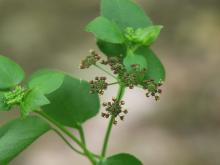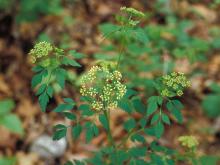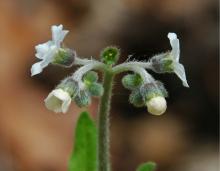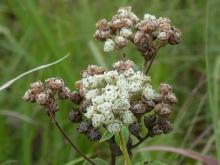Wildflowers, Grasses and Other Nonwoody Plants
Media

Species Types
Scientific Name
Centaurea stoebe
Description
Spotted knapweed is an invasive plant that outcompetes native communities, takes over pastureland, and even beats back invasive sericea lespedeza! It has arrived in our state. Let’s prevent its spread.
Media

Species Types
Scientific Name
Cirsium vulgare
Description
Bull thistle is a weedy introduction from Europe, found statewide. To tell it from our other thistles, note its stems with spiny-margined wings, and its leaves with the upper surface strongly roughened with stiff, spiny bristles.
Media

Species Types
Scientific Name
Cirsium altissimum
Description
Tall thistle is a native thistle that can grow to be 10 feet tall! To identify it, notice its leaves, which are unlobed (though they may be wavy or have only shallow, broad lobes), are felty-hairy beneath, and have prickles only along the edges.
Media

Species Types
Scientific Name
Pedicularis canadensis
Description
Wood betony has a tight spiral of tubular, hooded yellow flowers atop a plant adorned with deeply incised, fernlike leaves that are about as attractive as the flowers themselves. In early spring, these leaves have a beautiful wine-red coloration.
Media

Species Types
Scientific Name
Elephantopus carolinianus
Description
You may not recognize elephant’s foot as a member of the daisy or sunflower family because it lacks petal-like ray florets. Also, it has unusual, doubly compound flower clusters. And how did it get its name, anyway?
Media

Species Types
Scientific Name
Symphyotrichum pilosum (formerly Aster pilosus)
Description
White heath aster is one of Missouri's most widespread and weedy native asters. It grows in uplands, bottomlands, and nearly all habitats in between. It has a shrubby, wide-branching habit, and the stem leaves are thin and needlelike.
Media

Species Types
Scientific Name
Thaspium trifoliatum
Description
One of our more challenging plants to identify, meadow parsnip looks an awful lot like golden Alexanders. But you can do it! Look closely at the flower clusters and at the edges of the leaves, and then check the seeds.
Media

Species Types
Scientific Name
Zizia aurea
Description
Named for its resemblance to a European herb that was popular in Medieval times, golden Alexanders is a native Missouri wildflower with bright yellow flowers arranged in umbrella-like clusters.
Media

Species Types
Scientific Name
Cynoglossum virginianum
Description
Wild comfrey has large basal leaves that are soft, hairy, and elliptical with long petioles — they look like hounds’ tongues! The upright flowering stalk has few leaves and looks like a wand.
Media

Species Types
Scientific Name
Parthenium integrifolium
Description
A common component of high-quality upland prairie, American feverfew, or wild quinine, is a native wildflower that was used to treat fevers or malaria. It's in the composite family.
See Also
About Wildflowers, Grasses and Other Nonwoody Plants in Missouri
A very simple way of thinking about the green world is to divide the vascular plants into two groups: woody and nonwoody (or herbaceous). But this is an artificial division; many plant families include some species that are woody and some that are not. The diversity of nonwoody vascular plants is staggering! Think of all the ferns, grasses, sedges, lilies, peas, sunflowers, nightshades, milkweeds, mustards, mints, and mallows — weeds and wildflowers — and many more!





















